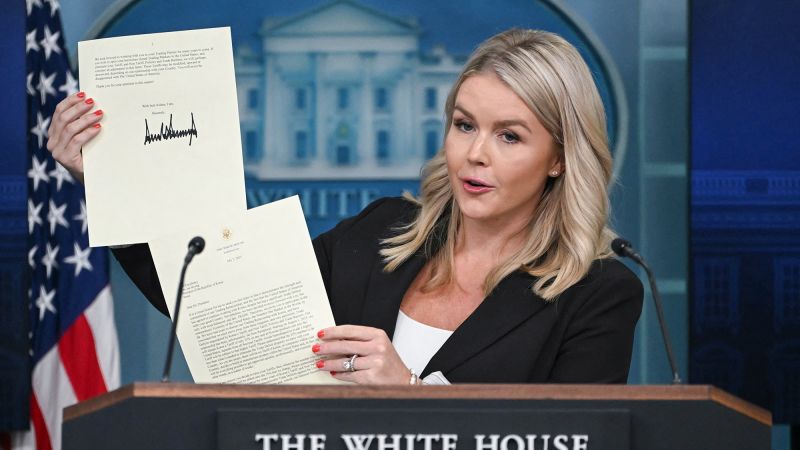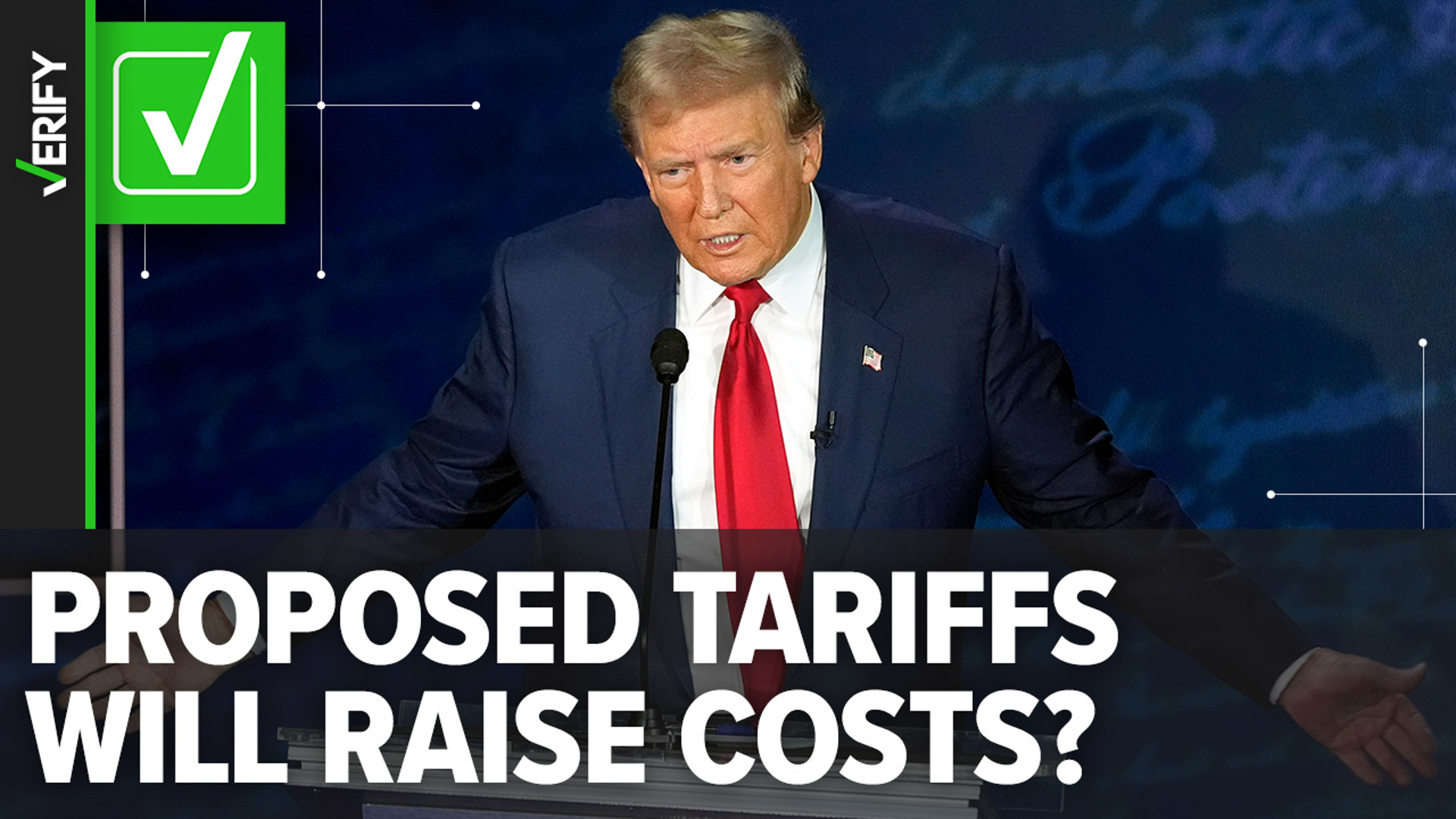Trump Announces New Tariffs in Ongoing Trade War

New Tariffs: Trump's Latest Move in the Trade War
President Donald Trump has once again taken a bold step in his ongoing trade war with multiple countries. On Monday, Trump announced new tariffs of up to 40% on a growing number of countries, including China, Mexico, and Canada. These tariffs come as a result of Trump's belief that these countries have been taking advantage of the United States in terms of trade.
The Pressure is On
In a series of letters sent to the heads of these countries, Trump informed them of the new tariff rates and urged them to take action to level the playing field for American businesses. This move is seen as a clear indication of Trump's commitment to protecting and promoting American economic interests.
The Executive Action
While the new tariffs are a significant escalation in the trade war, Trump also took some of the edge off by signing an executive action that would provide financial assistance to farmers who have been negatively impacted by the tariffs. This move is an attempt to ease the burden on American farmers, who have been hit hard by retaliatory tariffs from other countries.
Unintended Consequences
Despite Trump's intentions, these new tariffs are expected to have a ripple effect on the global economy. Many experts are concerned that this move could lead to an increase in prices for American consumers and potentially harm the country's overall economic growth. Additionally, this could result in a strain on relationships with key trading partners and further escalate the trade war.
The Future of the Trade War
This latest development in the trade war has left many wondering what the future holds. As tensions continue to rise, it is uncertain how other countries will respond to Trump's actions and what the long-term effects will be. One thing is for sure, the trade war is far from over and it is likely that we will see more back-and-forth moves from both sides in the near future.
Conclusion
In conclusion, Trump's announcement of new tariffs on a growing number of countries is a clear indication of his determination to protect American economic interests. While this move may have unintended consequences, it remains to be seen what the long-term effects will be. As the trade war continues, it is essential to closely monitor the situation and its impact on the global economy.
About the People Mentioned
Donald Trump
Donald John Trump, born June 14, 1946, in Queens, New York, is an American businessman, media personality, and politician. He graduated from the University of Pennsylvania’s Wharton School in 1968 with a degree in economics. In 1971, he took over his family’s real estate business, renaming it the Trump Organization, through which he expanded into building and managing skyscrapers, hotels, casinos, and golf courses. Trump gained widespread fame as the host of the reality TV show *The Apprentice* from 2004 to 2015, which helped establish his public persona as a successful entrepreneur. Trump entered politics as a Republican and was elected the 45th president of the United States, serving from 2017 to 2021. His presidency was marked by significant policy actions including tax cuts, deregulation, the appointment of three Supreme Court justices, renegotiation of trade agreements (notably replacing NAFTA with the USMCA), and a focus on immigration control including border wall expansion. He withdrew the U.S. from international agreements such as the Paris Climate Accord and the Iran nuclear deal, and engaged in a trade war with China. His administration’s response to the COVID-19 pandemic was criticized for downplaying the virus’s severity. Trump was impeached twice by the House of Representatives—first in 2019 for abuse of power and obstruction, and again in 2021 for incitement of insurrection—but was acquitted by the Senate both times. After losing the 2020 election to Joe Biden, Trump challenged the results, culminating in the January 6, 2021, Capitol riot. He remains a central figure in American politics, having won the 2024 presidential election and returned as the 47th president in 2025, continuing to promote policies aimed at economic growth, border security, and military strength[1][2][3][4].
About the Organizations Mentioned
China
China is not an organization but a sovereign nation and the world’s second-largest economy, playing a pivotal role in global business and technology. Since initiating economic reforms in 1978, China has transformed from a largely agrarian society into an upper-middle-income country with an average GDP growth of over 9 percent per year for decades, lifting nearly 800 million people out of poverty[2]. The country’s economic model initially focused on investment and export-oriented manufacturing but is now shifting towards higher-value services, domestic consumption, and low-carbon growth to address social, environmental, and structural challenges[2]. China’s government heavily directs industrial policy, promoting domestic innovation and technological self-reliance through plans like “Made in China 2025” and the 14th Five Year Plan (2021-2025). These initiatives target advanced technology sectors such as robotics, aerospace, new energy vehicles, biopharmaceuticals, and high-tech manufacturing, aiming to replace foreign technologies with domestic alternatives and expand China’s global market presence[3]. This industrial strategy combines state subsidies, preferential policies, and strict market access controls for foreign firms, shaping a competitive environment favoring national champions[3]. Despite solid economic growth—real GDP grew by 5.4% year-on-year in early 2025—China faces headwinds including demographic shifts, slowing productivity, a cooling property market, and global trade uncertainties. Growth is projected to moderate to around 4.5% in 2025 and 4.0% in 2026, with fiscal stimulus helping to offset some challenges[1][3][6]. Externally, China remains a major global exporter, with exports outpacing GDP growth in 2025[6]. Notably, China’s governance under President Xi Jinping has tightened control over civil society, media, and minority regions, drawing international scrutiny for human rights issues and repression, especially of Uyghurs and Tibetans[4][9]. Meanwhile, Chin
Mexico
**Introduction to Mexico as a Country and Economy** Mexico is not an organization but a country, and it plays a significant role in global business and technology. With a population of nearly 130 million, Mexico is one of the largest economies in the world and the second largest in Latin America[1]. The country is known for its rich cultural heritage, diverse geography, and abundant natural resources. **History and Economic Overview** Historically, Mexico's economy has grown at an average annual rate of just over 2% between 1980 and 2022, which is relatively slow compared to other emerging economies[1]. Despite this, Mexico has a strong manufacturing base and is integrated into global value chains, particularly in the automotive and electronics sectors. **Key Achievements and Current Status** - **Economic Growth**: Despite recent challenges, Mexico's economy surprised with a 1.8% growth in the first half of 2025, driven by export growth and a resilient services sector[2]. However, the outlook remains cautious due to anticipated trade policy shifts and economic slowdown in the U.S.[1][2]. - **Poverty Reduction**: The official multidimensional poverty rate has decreased from 43.2% in 2016 to 36.3% in 2022, driven by labor market improvements and increased remittances[1][5]. - **Challenges**: Mexico faces significant challenges, including high income inequality, a low tax-to-GDP ratio, and a struggling energy sector[5][2]. **Notable Aspects** - **Investment Climate**: The government aims to reduce the fiscal deficit, which could impact investment decisions[6]. Constitutional changes and regulatory uncertainties have eroded trust in foreign investment[3]. - **Technology and Innovation**: Mexico has opportunities for growth in technology and innovation, particularly in sectors like IT services and renewable energy, though it faces challenges in infrastructure and regulatory environments. Overall, Mexico presents a complex economic landscape with both opportunities and challenges
Canada
**Introduction to Canada** Canada is not an organization but a country known for its vast economic and natural resources. It is the ninth-largest economy globally, with a highly developed mixed economy that is deeply integrated into the global trade system[6]. Here's a summary of Canada's key aspects relevant to business and technology: ## History and Role Canada has a long history of economic development, with significant contributions to global trade and finance. It is a founding member of the World Bank Group and has played a crucial role in international development initiatives[8]. ## Key Achievements - **Economic Contributions**: Canada is one of the world's largest trading nations, with strong trade relationships, particularly with the United States[6]. - **Innovation and Competitiveness**: It ranks high in the Global Competitiveness Report and Global Innovation Indexes, indicating its strong capabilities in innovation and business[6]. - **Multilateral Engagement**: Canada has been a strong proponent of multilateralism, supporting global development goals through its membership in the World Bank Group[8]. ## Current Status - **Economic Challenges**: Canada faces challenges such as rising tariffs with the U.S., weak productivity, and high household debt, which impact its economic growth[2][4]. - **Population Growth**: The country has experienced rapid population growth, driven largely by immigration, which has both bolstered labor input and strained housing affordability[9]. - **Resilience**: Despite these challenges, Canada's economy remains resilient, with a strong policy framework supporting macroeconomic stability[2]. ## Notable Aspects - **Trade Relations**: The U.S. is Canada's largest trading partner, with significant trade in goods and services[6]. - **Innovation and Technology**: Canada is home to vibrant tech hubs, such as Toronto and Vancouver, and supports innovation through various government initiatives. - **Global Influence**: Canada plays a significant role in international forums, promoting sustainable development and economic cooperation[8].
American Farmers
## Overview “American Farmers” is not a single, centralized organization, but rather a collective term for the millions of individuals and families who operate farms and ranches across the United States. However, several prominent organizations advocate for, represent, and support these farmers, each with distinct missions, histories, and achievements. Below is a focused summary of three leading groups—American Farmland Trust, American Farm Bureau Federation, and National Farmers Union—that embody the spirit and interests of American farmers. ## American Farmland Trust Founded in 1980, American Farmland Trust (AFT) is a pioneering nonprofit dedicated to conserving agricultural land, promoting environmentally sound farming practices, and helping farm families remain on their land[1]. AFT’s holistic approach recognizes the interdependence of land, farming practices, and farmers’ livelihoods. The organization is famous for its *No Farms No Food®* campaign, emphasizing the critical link between farmland and food security[1]. Over the decades, AFT has protected millions of acres from development and assisted tens of thousands of farmers in adopting sustainable practices. Despite these successes, challenges persist: 2,000 acres of farmland are lost daily to non-agricultural uses, and a third of U.S. farmland may change hands in the next 15 years as older farmers retire[1]. AFT’s advocacy, research, and on-the-ground projects aim to ensure that farmland remains productive and accessible for future generations. ## American Farm Bureau Federation The American Farm Bureau Federation (AFBF), established in 1919, is the nation’s largest grassroots farm organization, representing farmers, ranchers, and rural communities[2]. AFBF is known as the *Voice of Agriculture®*, shaping policy through a bottom-up approach: local members propose policies that ascend to state and national levels[2]. The organization provides business tools, leadership development programs (such as Young Farmers & Ranchers), and consumer outreach to build trust in agriculture[














